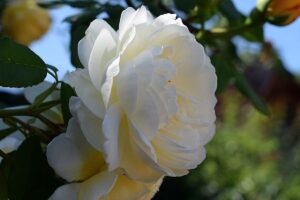Eurybia divaricata
White wood asters, Eurybia divaricata, are native perennials in the Asteraceae family, which also includes chrysanthemums, coneflowers, and sunflowers.
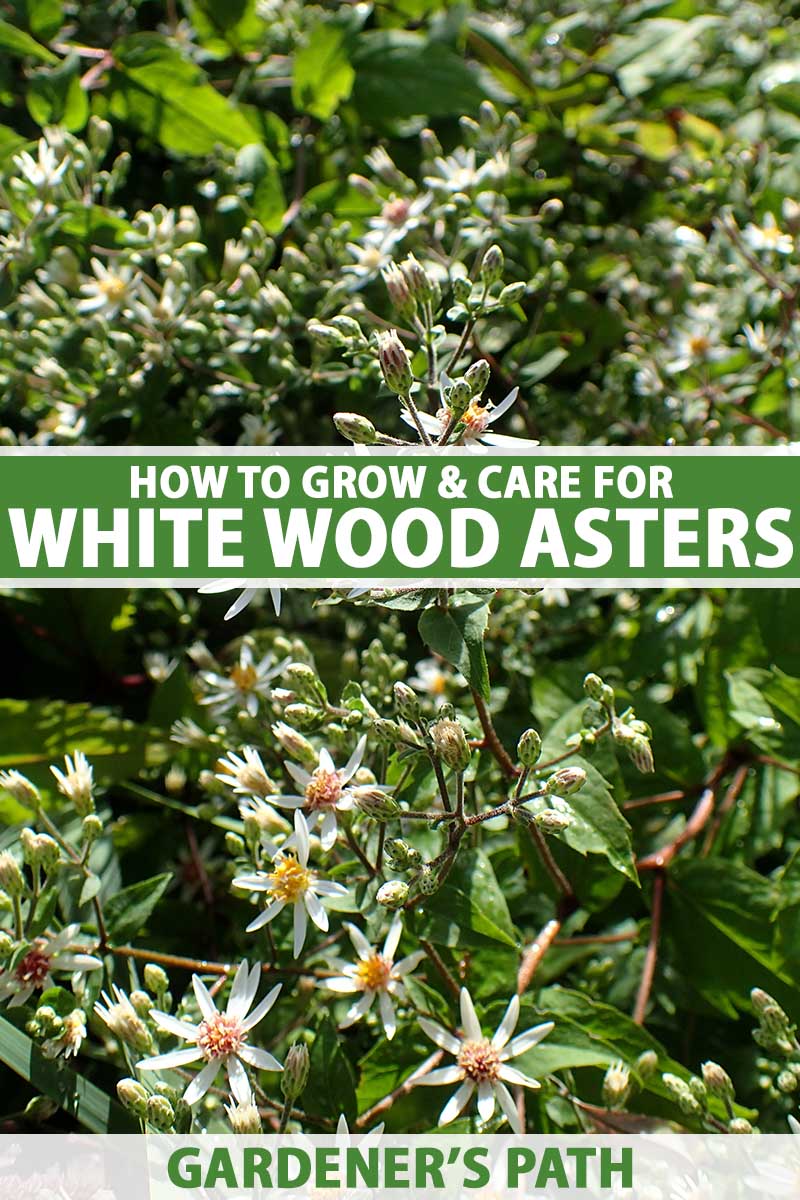
We link to vendors to help you find relevant products. If you buy from one of our links, we may earn a commission.
Suited to cultivation in USDA Hardiness Zones 3 to 8, these eastern North American wildflowers are a boon to woodland gardeners in naturalistic settings with room for masses of tiny white blossoms beneath a shady canopy of trees and woody shrubs.
In our guide to growing asters, we discuss the different aster species and their cultivation.
This article discusses how to grow and care for the white wood aster.
Here’s what we’ll cover:
What You’ll Learn
Let’s get started!
What Are White Wood Asters?
White wood asters are herbaceous perennial wildflowers with an upright and mounding growth habit.
The green to black stems are crooked and bear distinctively heart-shaped green leaves with deeply serrated edges.
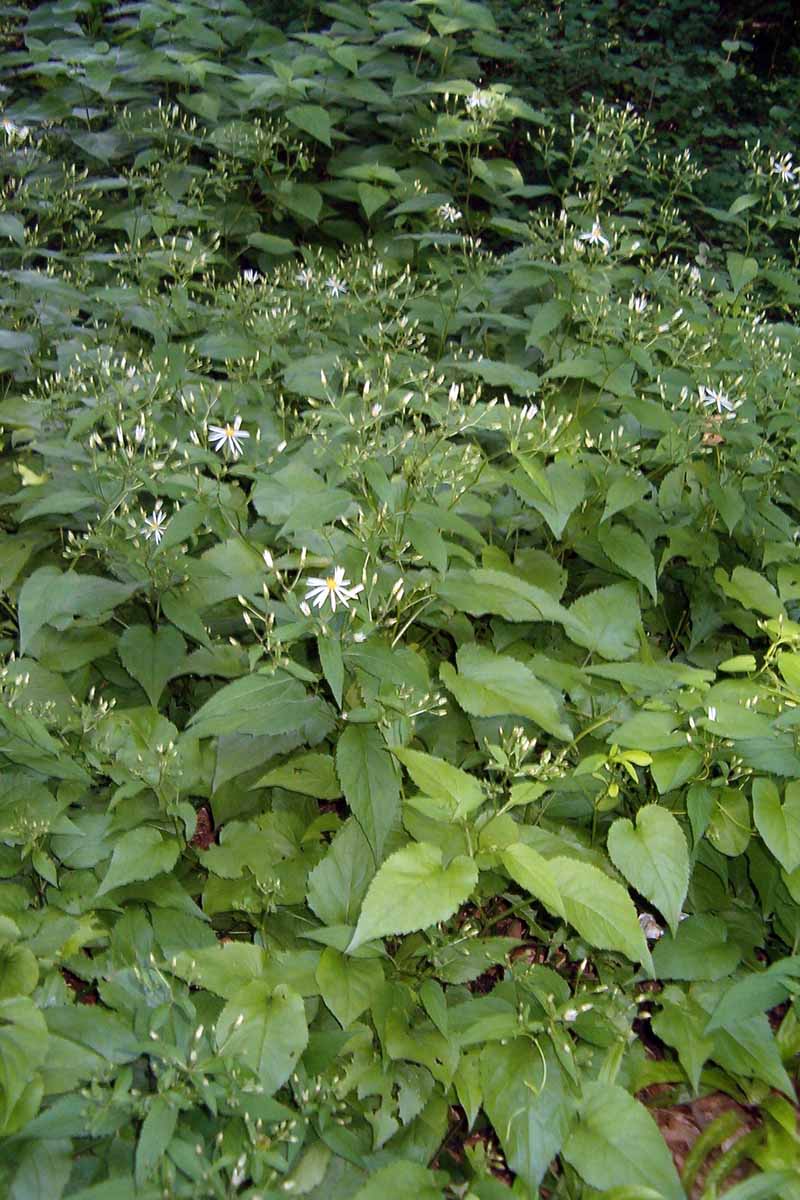
Small florets measure less than one inch across and consist of up to 10 slender white rays around a center disk of yellow shading to reddish-brown.
They appear as a flattened corymb at the terminal ends of the stems.
Mature dimensions are 12 to 36 inches tall and 18 to 30 inches wide, achieved in two to five years.
Plants naturalize readily, spreading by rhizomes and self-sown barbed, bristle-like seeds that cover the plants in cottony tufts at season’s end.
Cultivation and History
E. divaricata is suited to home garden cultivation in informal, natural settings where its bushy nature and myriads of tiny blossoms are unfettered by formal beds and borders.
The botanical species and a small number of cultivars, aka nativars, are available, as we will soon discuss.
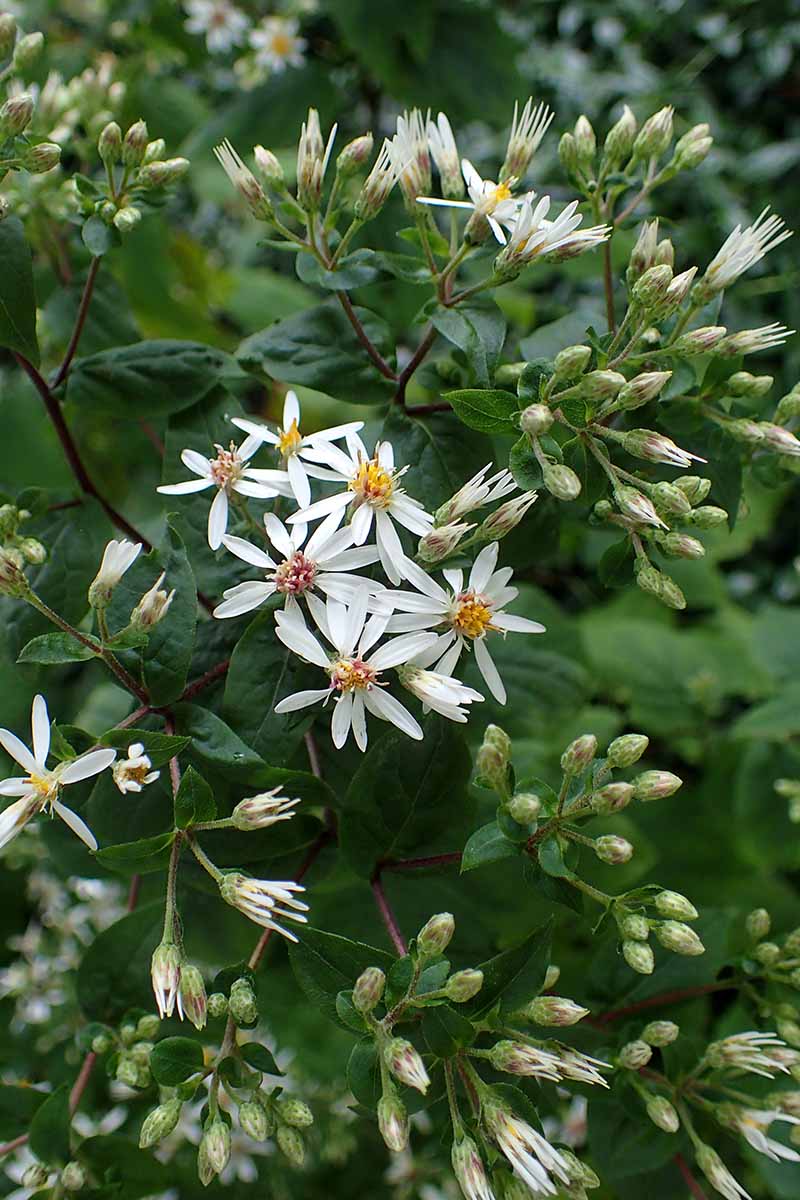
Aster flowers, foliage, and roots have a long history of use in Native American traditional medicine.
The young, tender leaves of E. divaricata are nontoxic and palatable when cooked. However, they are most often grown neither for food nor ornamental value.
Native perennial asters are classified as “filler” in the florist’s “thriller,” “filler,” “spiller” formula for a well-balanced, attractive arrangement.
These cloud-like mounds of fluff are neither showy nor gravity-defying and lack the ornamental value of larger “focal” flowers with thriller and spiller qualities.
Their claim to fame is the ability to produce copious quantities of small florets that attract beneficial pollinators and wildlife.
These wildlife species coevolved with E. divaricata and continue to seek it out for survival. Brightening up dark areas of the landscape is a bonus.
Propagation
To propagate E. divaricata, you’ll need plants, seeds, soft stem cuttings, or divisions. You can read all about each method in our article on aster propagation.
For nursery plants, seedlings, and rooted soft stem cuttings, note the depth they sit in their containers, and set them at the same depth in the garden soil when they’re ready to transplant. For divisions, replicate their depth in the ground before you dug them up.
Allow 18 to 30 inches between plants.
Tamp soil firmly around the stems. Water and tamp again to squelch air pockets.
Apply a slow-release, granular, all-purpose fertilizer around the stems. Don’t let the product touch any plant tissue, as it may burn.
If planting seeds, moisten the soil lightly, and scatter several seeds at intervals of 15 to 18 inches.
Once they have two sets of true leaves, you can thin seedlings to intervals of 18 to 30 inches and apply a slow-release fertilizer to damp soil, as we did above.
Maintain even moisture, about an inch of water per week, including rain, to establish healthy roots without oversaturation.
How to Grow
Once you have potted nursery plants, seeds, seedlings, rooted soft stem cuttings, or divisions, and the last spring frost date has passed, it’s time to plant.
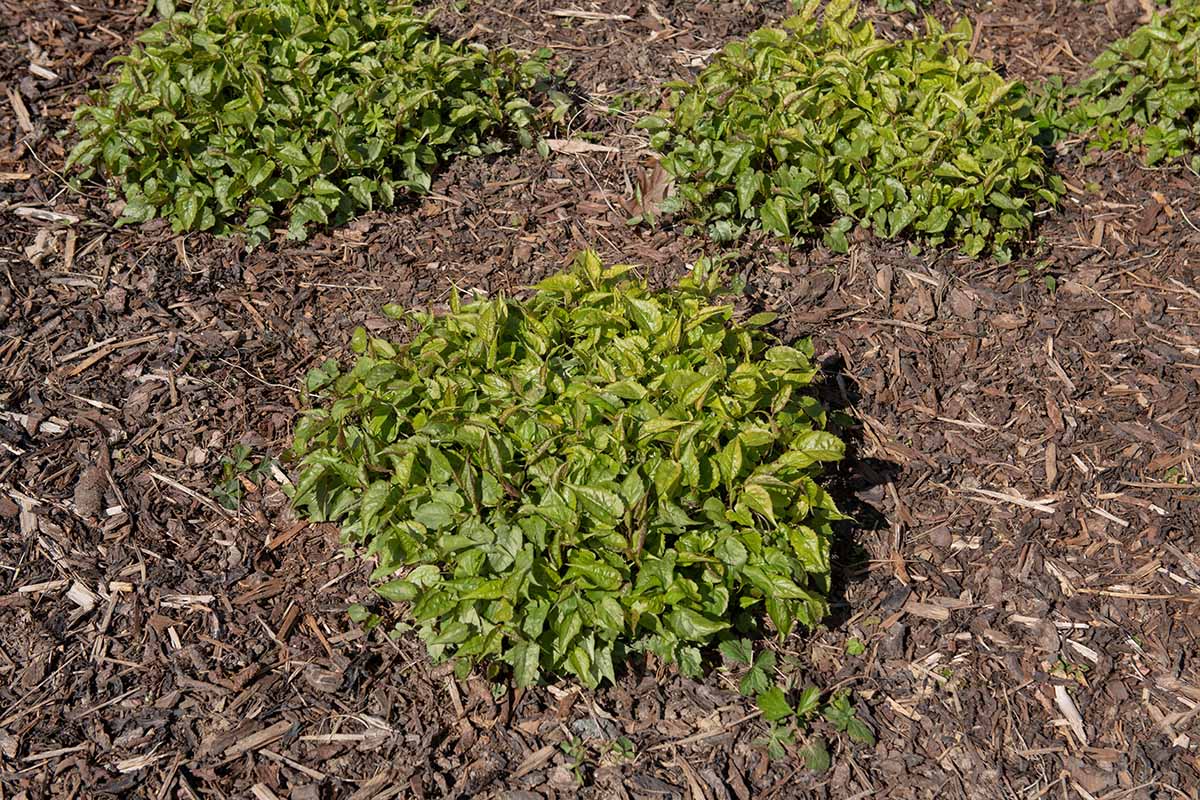
The best location for E. divaricata is a partially to fully shaded area with average soil and a neutral to slightly acidic pH of 6.8 to 7.2.
The drainage should be excellent, as standing water invites pests and fungal diseases and may result in rotting.
Work the soil to a depth of eight to 10 inches until you achieve a smooth, crumbly consistency.
As you begin, keep in mind that generous spacing prevents overcrowding and maximizes airflow to inhibit moisture-loving pests, diseases, and rotting. We will discuss pests and diseases shortly.
Mature plants have low to medium water needs and exhibit above average tolerance of deer, drought, and dry/rocky soil.
Growing Tips
It’s easy to plant E. divaricata when you remember the following:
- Prepare the garden bed to a depth of 8 to 10 inches for smooth, crumbly soil.
- Note the depth of plants, seedlings, rooted stem cuttings, and divisions, and set them at their original depth in the garden soil.
- Moisten the soil and sow the seeds on the surface.
- Space generously to avoid overcrowding and support air circulation.
- Apply granular fertilizer to plants at planting time and seedlings once they have two sets of true leaves. Take care not to let it touch the stems or foliage.
- Maintain even moisture, an inch per week, to help plants establish healthy roots.
With planting done, let’s move on and discuss ongoing care tasks.
Pruning and Maintenance
Trimming the foliage by up to one-third in early summer promotes more compact, less leggy growth for a more uniform, mounded appearance at bloom time with less need for staking.
Even without early pruning, E. divaricata is less likely to require staking than other aster species.
Additional maintenance includes removing broken, diseased, or pest-infested foliage as needed, cutting all stems to the ground at season’s end, and discarding cut stems to deprive rodents and other pests of shelter during and after the growing season.
In the spring, apply an all-purpose, slow-release, granular fertilizer to support a healthy start to the season.
Cultivars to Select
In addition to botanical species E. divaricata, there are several cultivated varieties or nativars.
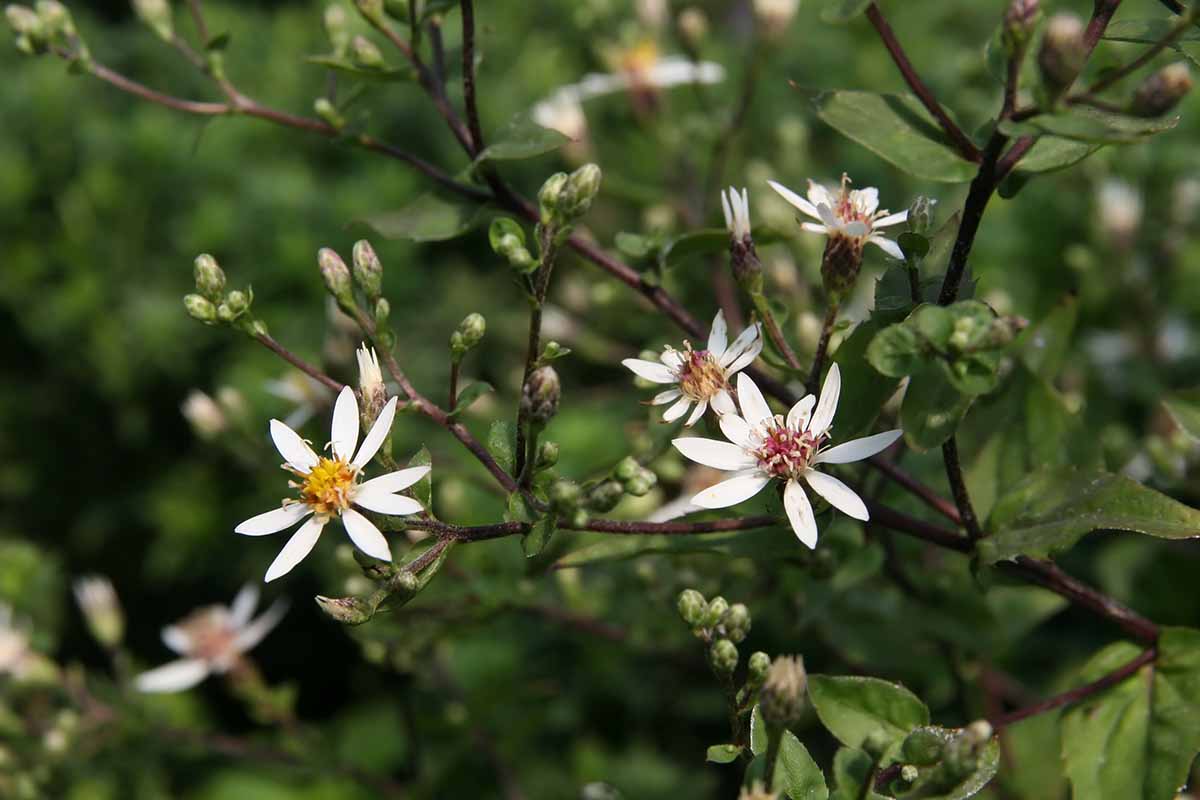
E. divaricata ‘Eastern Star’ has black stems, a height of 24 inches, and a spread of 24 to 36 inches.
‘Fiesta’ is 20 inches tall and 10 inches wide with a hint of lavender in the floret rays.
‘Raiche Form’ is approximately 20 inches tall and wide with one-inch florets.
‘Snow Heron’ is 12 to 18 inches tall and nine to 12 inches wide.
Purchasing sources include native seed and plant exchanges and native plant nurseries. Please do not dig up wild plants as doing so disrupts fragile ecosystems and displaces wildlife.
Managing Pests and Disease
White wood asters are not prone to pests or diseases.
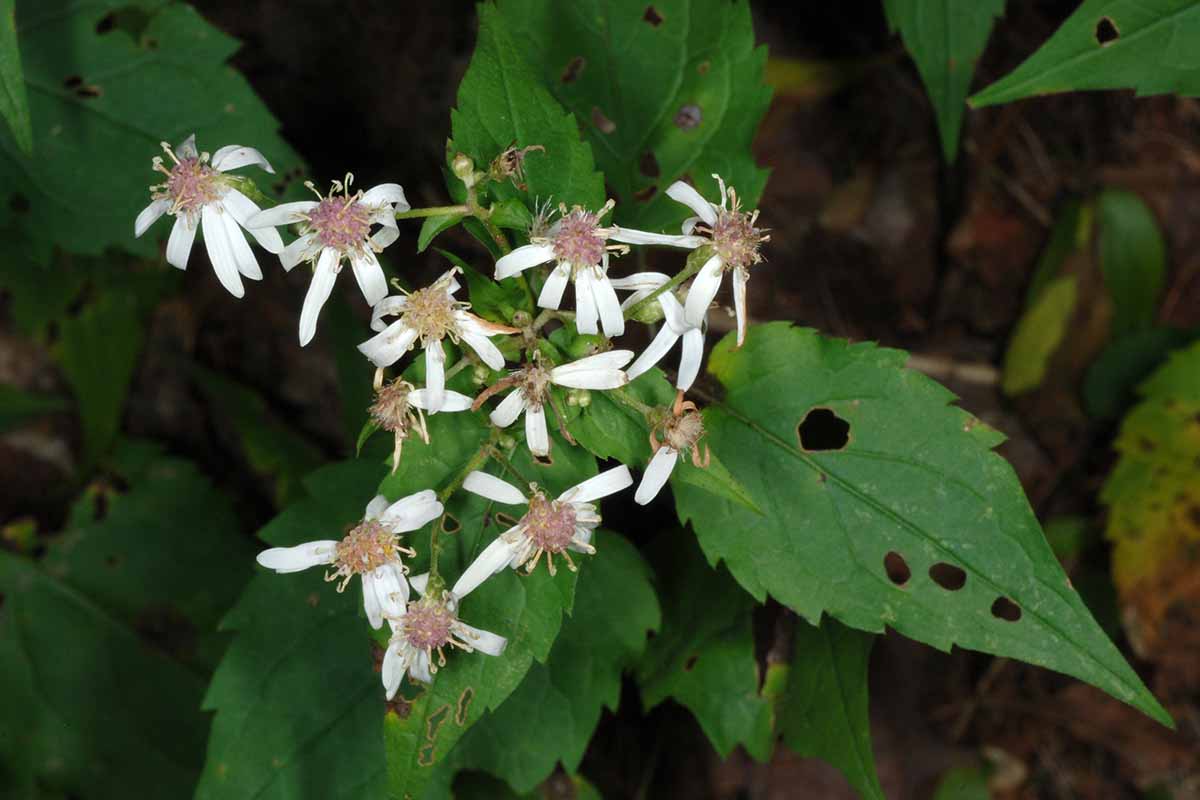
However, as shade plants, they may become vulnerable to both when plants are too close together and/or drainage is poor.
Slugs and snails are drawn to dark, moist foliage and may chew voraciously, leaving telltale holes or consuming entire leaves.
And fungal conditions, like fusarium wilt and powdery mildew, may proliferate on perpetually wet surfaces.
Advanced fungal disease may lead to rotting and plant death.
Best Uses
The best way to showcase this large, bushy perennial with many tiny florets is to plant it en masse as a filler in the understory of naturalistic woodland settings.

It is at home in the filtered to full shade this space affords, and provided the soil drains well, and plants are spaced generously, it should not be overly prone to moisture-loving pests or diseases.
Consider including specimen plantings in existing butterfly, native plant, and shade gardens where it can pair with flowering plants with similar cultural requirements.
See our aster companion plants article for ideas.
Additional practical and attractive uses include scattering seeds to naturalize randomly in woodland settings, especially where erosion is problematic or along perimeters, for an informal herbaceous late summer to fall privacy hedge and wildlife habitat.
Quick Reference Growing Guide
| Plant Type: | Herbaceous flowering perennial | Flower / Foliage Color: | White/green |
| Native to: | Eastern North America | Maintenance: | Low to moderate |
| Hardiness (USDA Zone): | 3-8 | Tolerance: | Deer, deep shade, drought, dry/rocky soil |
| Bloom Time: | Late summer to fall | Soil Type: | Average |
| Exposure: | Part to full shade | Soil pH: | 6.8-7.2 |
| Time to Maturity: | 2-5 years | Soil Drainage: | Well-draining |
| Spacing: | 15-18 inches (seed); 18-30 inches (transplants) | Attracts: | Native bees and butterflies, songbirds, other wildlife |
| Planting Depth: | Surface sow (seed), container/root depth (transplants) | Uses: | Butterfly garden, informal hedge, mass planting, naturalized planting, shade garden, native plant garden, woodland settings |
| Height: | 12-36 inches | Order: | Asterales |
| Spread: | 18-30 inches | Family: | Asteraceae |
| Water Needs: | Low to moderate | Genus: | Eurybia |
| Common Pests and Diseases: | Slugs; Fusarium wilt, powdery mildew | Species: | Divaricata |
A Walk on the Wild Side
White wood asters are a woodland gardener’s wildflower friend, lighting up shady recesses of the landscape with cloud-like masses of tiny white blooms.
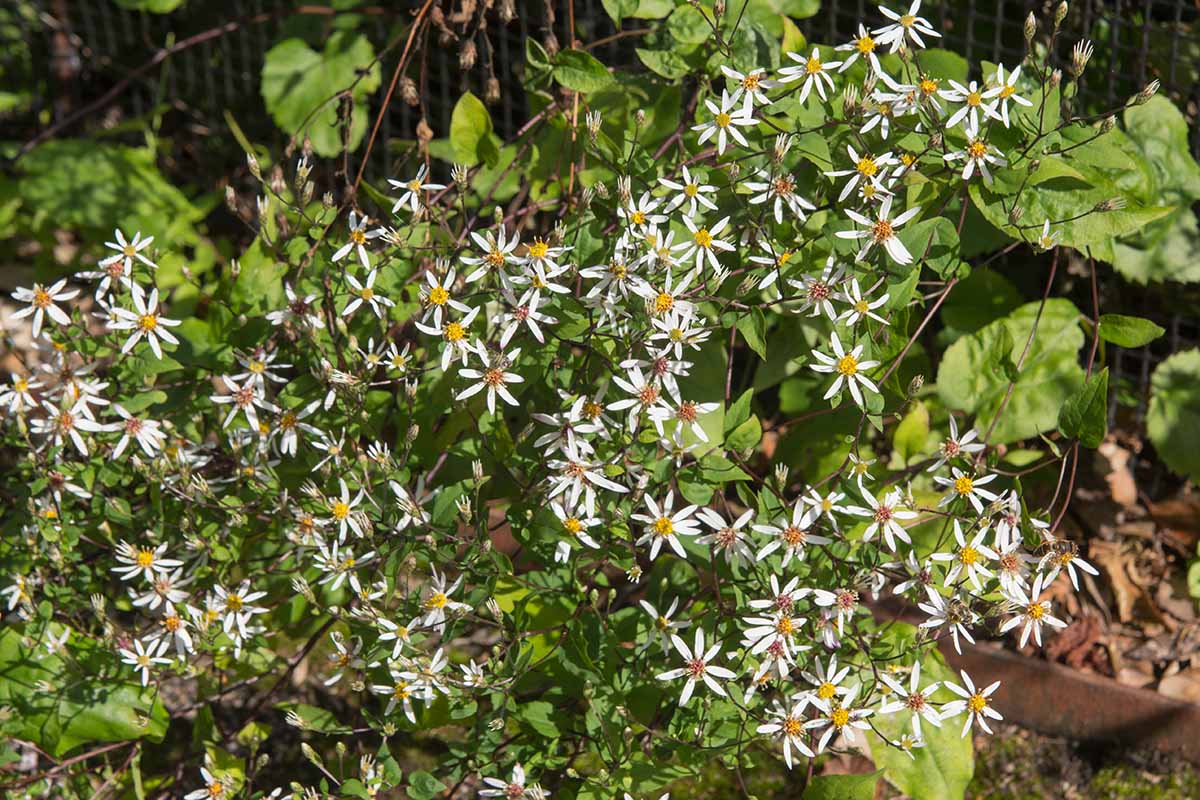
And as a rich source of nectar for late-season pollinators, they support local wildlife and a diverse growing environment.
Are you ready to take a walk on the wild side?
Add E. divaricata to your garden planner now and prepare to delight in frothy mounds of white.
If you found this guide informative and want to learn about other native species of asters, we recommend the following:

